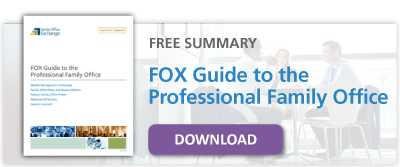“Profits Interest” Structure Approved for Family Office

Two events in December 2017 presented new tax challenges for family offices and provide a reason to evaluate the structure of the office and the current classification of family office expenses. One is the US Tax Court’s decision in Lender Management v. Commissioner, TC Memo 2017-246 (“Lender”), and the other is the 2017 Tax Act (“Act”).
Everyone is focusing on and planning for the provisions of the Act, but the Lender decision is also something you should pay attention to for your family office. The decision is important in that it provides a sort of “road-map” for family offices to follow to retain their ability to deduct appropriate operating expenses.
Can Single Family Offices Still Deduct Operating Expenses under Section 162?
Flow-through entity Lender Management LLC, a tax partnership formed to provide management services to LLCs owned by family members, was functioning as a family office for the Lender family. At issue in Lender:
- Whether the entity was operating as an active “trade or business,” and thus eligible to deduct operating expenses under Section 162 of the internal revenue code
OR
- Whether the entity was simply providing administrative services, investment oversight and record keeping for the investor LLCs, and thus not eligible to deduct under Section 162 but rather treated as Section 212 expenses that are no longer deductible by individuals and severely limited for trusts
Findings of the Tax Court in Lender Management v. Commissioner
The Tax Court found that Lender Management was, in fact, engaged in a trade or business and could deduct its operating expenses, stating in its decision, “Lender Management was not managing its own money. Most of the assets under management were owned by members of the Lender family that had no ownership interest in Lender Management. Lender Management managed investments and did substantially more than keeping records and collecting interest and dividends.” (Lender at pg. 37). The Court’s explanation of its findings (summarized below) provides the map for family offices to follow in examining their current structure and deduction decisions.
1. Structure of Family Office for Lender Family
- Partnership for tax purposes
- Profit-based model
- Three separate Family Investment LLCs called “clients”
- Lower tiered investments included non-family members
- Family Office owned principally by one G3 member
- Family Investment LLCs included members of G2, G3 and G4
- Only 2 of 5 families of G2 were “clients”
- Investors could withdraw their investments at any time
- Full time manager position and a non-family CFO
- During years of audit, G1 founder of Family Office was deceased and G1 trust was not involved
2. Business Activities of Family Office for Lender Family
- Manage investments, investment LLCs and office personnel
- Research and pursue new investment opportunities
- Review approximately 150 private equity and hedge fund proposals per year
- Manage other downstream entities which include non-family investors
- Provide investment and financial planning services for individual members of LLCs
- Meet with and attend presentations of hedge fund managers, private equity managers, and investment bankers
- Enter private equity deals and make hedge fund trades
- Conduct annual business meetings with each client
- Develop investment options to individual client needs
- Prepare monthly, quarterly and annual reports
- Interview and acquire outside investment and accounting firms for services
3. Compensation to Family Office for Lender Family
- Profits Interest in each of the LLCs based on portfolio value and performance not greater than income
Takeaways for Single Family Offices from Lender Management v. Commissioner Decision
For a partnership family office structure to qualify to deduct the operation expenses under Section 162:
- It is important to show that the office is carrying on an active trade or business and not just providing administrative or investment oversight services for the family.
- It is important to create documented, legally-distinct family entities within the family office. These entities need to have documented, professional, business relationships with each other, as evidence that family members are not acting “collectively or with a single mindset.”
Family office compensation received was a factor in the Tax Court’s decision because it distinguished the situation where the family office generates income based on a “normal investor’s return” (Lender at 26). However, the structuring of compensation as fees paid versus issuance of a profits interest was not a factor.
This is important for family offices to note because:
- Investment fees paid by the LLCs under the Act are not tax deductible
- Profits interest allocations reduce taxable income allocable to the other members of the LLCs
Even if your family office is structured as a corporation, the above points are important to note as they represent good practices to lessen susceptibility to other tax vulnerabilities, such as personal holding company tax.
In summary, this case is important not in that it is groundbreaking or surprising, but rather that it provides guidance for the tax efficient structuring of family offices, especially as offices and families move forward with the changes necessitated by the Tax Act. The case was labeled as a memorandum decision, meaning that settled law was applied to the facts and one Tax Court judge issued the opinion.
Furthermore, as an observation, the Lender Family Office and Family Held Investments had evolved beyond the original patriarch in terms of structure and in terms of family cohesiveness. However, this does not mean that the Lender structure can’t be achieved in the early years of a family office. The important item to note is that, regardless of the developmental stage of the office, its structure must evidence that the management is not merely of one’s own wealth.
